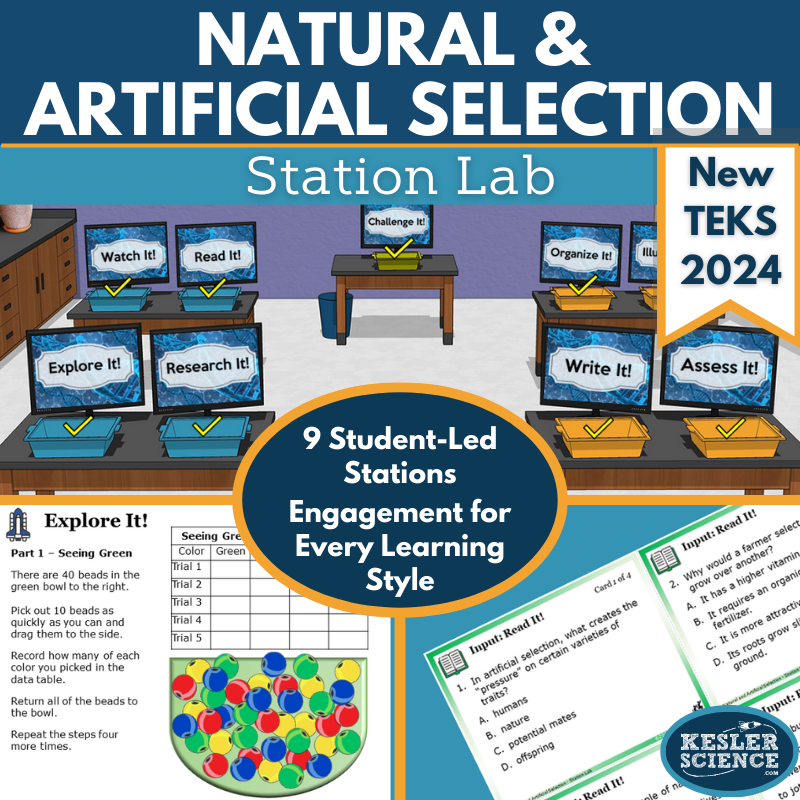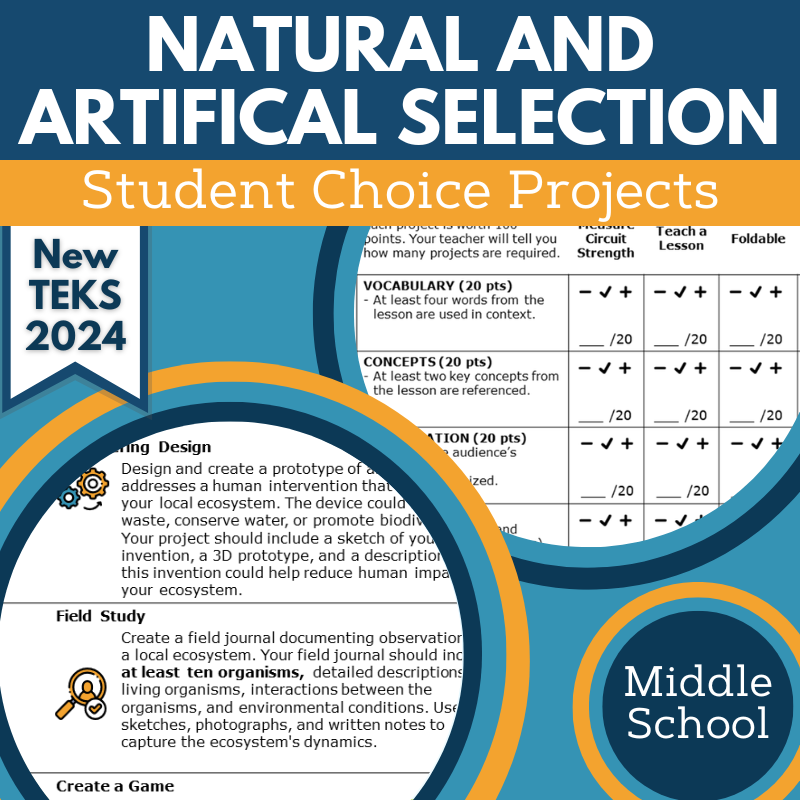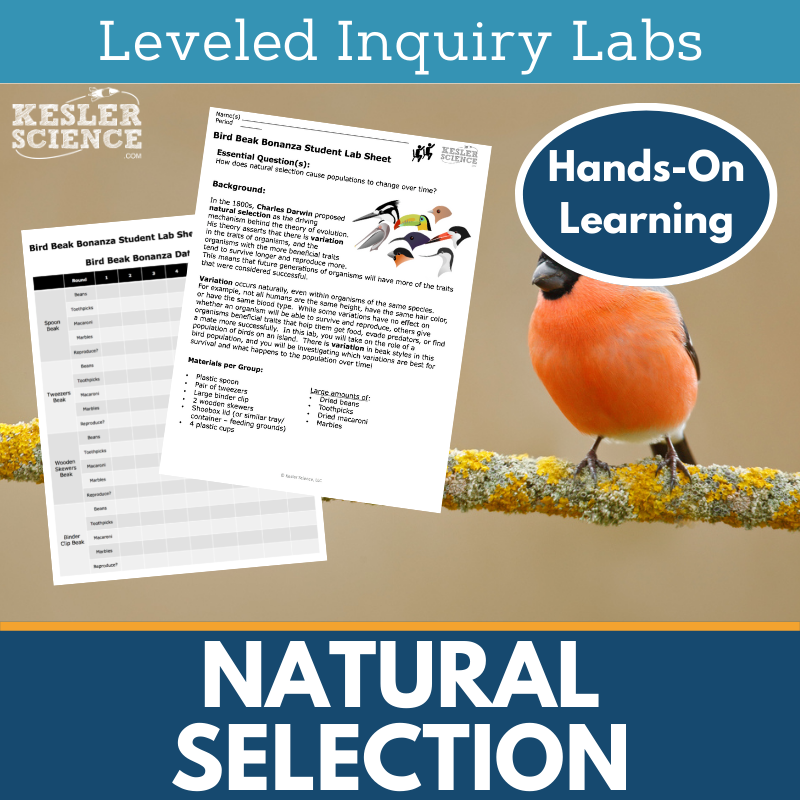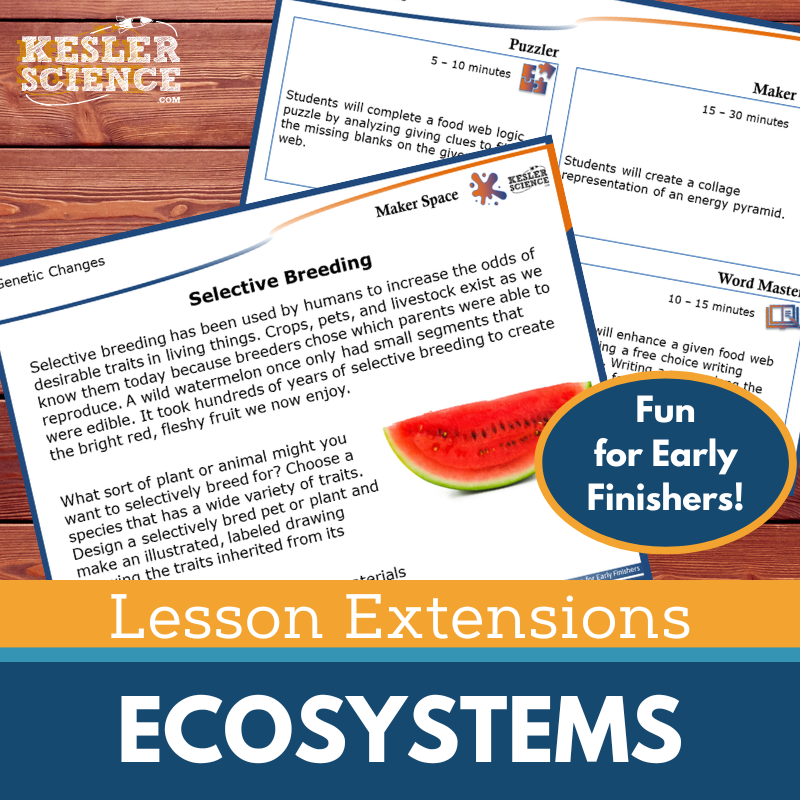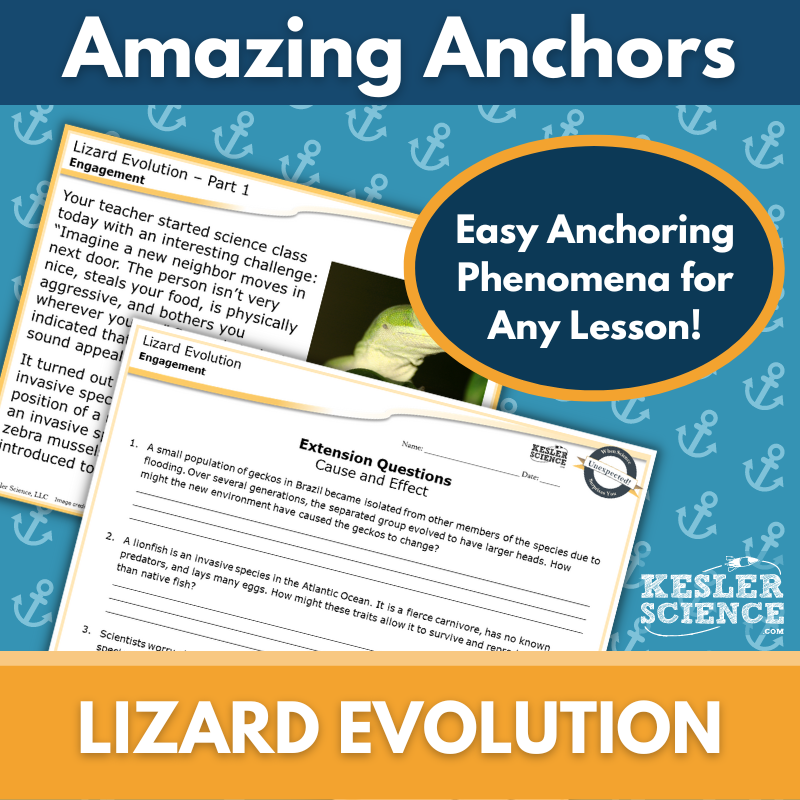Natural & Artificial Selection Activities for Middle School Science
This middle school ecosystems unit explores how natural and artificial selection influence traits in populations across generations. The resources below will give students a comprehensive understanding of natural and artificial selection. All of the following materials are also included in the Kesler Science Membership.
This middle school ecosystems unit explores how natural and artificial selection impact the occurrence of traits in populations over generations. It includes editable PowerPoints, worksheets, student-choice projects, and assessments. The materials are differentiated, require minimal prep, and cater to diverse learning styles, ensuring an engaging student-led learning experience.
The lesson follows the 5E Model and covers the essential questions: How does natural selection change traits in a population over generations? How does artificial selection change traits in a population over generations?
Key features include differentiated resources for all learners, multimodal activities (hands-on demos, reading passages, videos, research), and flexible formats (printable and digital). The exploration phase includes a nine-station lab that lets students investigate how selection affects survival and reproduction. Students can organize, write, illustrate, and assess their learning at various stations, with a bonus “Challenge It!” station for extension activities.
Additional resources include interactive notebooks, project-based elaboration activities, and STAAR 2.0-aligned assessments. The lesson is designed for both in-class and virtual learning environments. It aligns with the 2021 TEKS 7.13D standard and is available in both English and Spanish.
This middle school ecosystems unit explores how natural and artificial selection impact the occurrence of traits in populations over generations. It includes editable PowerPoints, worksheets, student-choice projects, and assessments. The materials are differentiated, require minimal prep, and cater to diverse learning styles, ensuring an engaging student-led learning experience.
The lesson follows the 5E Model and covers the essential questions: How does natural selection change traits in a population over generations? How does artificial selection change traits in a population over generations?
Key features include differentiated resources for all learners, multimodal activities (hands-on demos, reading passages, videos, research), and flexible formats (printable and digital). The exploration phase includes a nine-station lab that lets students investigate how selection affects survival and reproduction. Students can organize, write, illustrate, and assess their learning at various stations, with a bonus “Challenge It!” station for extension activities.
Additional resources include interactive notebooks, project-based elaboration activities, and STAAR 2.0-aligned assessments. The lesson is designed for both in-class and virtual learning environments. It aligns with the 2021 TEKS 7.13D standard and is available in both English and Spanish.
This student-led activity aligned with TEKS 7.13D focuses on natural and artificial selection, designed to engage middle school students in life science. It offers a flexible, modular structure where students direct their own learning while exploring how natural and artificial selection affect traits in populations over generations. This activity is perfect for both in-class and virtual environments, providing comprehensive, low-prep materials to facilitate a dynamic learning experience.
The station lab consists of nine differentiated stations, each offering unique activities, resources, and task cards for students to complete independently or in small groups. Input stations, such as Explore It!, Watch It!, Read It!, and Research It!, introduce students to key concepts using hands-on tasks, videos, reading passages, and research materials. These stations help students build their understanding of natural and artificial selection through multimodal learning methods.
Output stations like Organize It!, Illustrate It!, Write It!, and Assess It! provide opportunities for students to demonstrate their learning. Whether through manipulatives, sketches, written responses, or task card assessments, these stations support students in applying and communicating their knowledge. Additionally, the bonus Challenge It! station offers extension activities for early finishers and advanced learners. The activity is designed for both virtual and in-person settings, with resources that can easily be adapted for digital platforms.
This student-led activity aligned with TEKS 7.13D focuses on natural and artificial selection, designed to engage middle school students in life science. It offers a flexible, modular structure where students direct their own learning while exploring how natural and artificial selection affect traits in populations over generations. This activity is perfect for both in-class and virtual environments, providing comprehensive, low-prep materials to facilitate a dynamic learning experience.
The station lab consists of nine differentiated stations, each offering unique activities, resources, and task cards for students to complete independently or in small groups. Input stations, such as Explore It!, Watch It!, Read It!, and Research It!, introduce students to key concepts using hands-on tasks, videos, reading passages, and research materials. These stations help students build their understanding of natural and artificial selection through multimodal learning methods.
Output stations like Organize It!, Illustrate It!, Write It!, and Assess It! provide opportunities for students to demonstrate their learning. Whether through manipulatives, sketches, written responses, or task card assessments, these stations support students in applying and communicating their knowledge. Additionally, the bonus Challenge It! station offers extension activities for early finishers and advanced learners. The activity is designed for both virtual and in-person settings, with resources that can easily be adapted for digital platforms.
The Natural & Artificial Selection Student Choice Projects align with the 2021 TEKS standard 7.13D and offer middle school students a variety of project options to showcase their understanding. A project page presents six student-led project choices along with a "design your own" option. An editable grading rubric allows for assessments by teachers, peers, or the students themselves.
These projects are flexible and support creativity, giving students the chance to choose a personalized approach. The rubric can be adjusted to meet different grading needs. There are modified versions of the project page for students who need remediation, as well as challenge options for advanced learners.
The projects use standard classroom supplies like paper, markers, and scissors, and many can be completed digitally.
The Natural & Artificial Selection Student Choice Projects align with the 2021 TEKS standard 7.13D and offer middle school students a variety of project options to showcase their understanding. A project page presents six student-led project choices along with a "design your own" option. An editable grading rubric allows for assessments by teachers, peers, or the students themselves.
These projects are flexible and support creativity, giving students the chance to choose a personalized approach. The rubric can be adjusted to meet different grading needs. There are modified versions of the project page for students who need remediation, as well as challenge options for advanced learners.
The projects use standard classroom supplies like paper, markers, and scissors, and many can be completed digitally.
Students will investigate beak variation in birds, learning how populations naturally contain trait variation and how some variations impact survival. Through role play, each student will simulate being a bird with a specific beak type and attempt to pick up objects, analyzing their success rate. This helps students understand how beneficial variations can enhance survival, leading to population changes over time.
The lab includes three differentiated versions: a Dependent Lab with guided questions for on-level learners, a Modified Lab for students needing more structure, and an Independent Lab for advanced learners. Materials for the activity include everyday items such as plastic spoons, tweezers, and dried beans.
Aligned to TEKS and NGSS, the lab explores genetic traits and natural selection in organisms, using evidence to explain the influence of environmental and genetic factors.
Students will investigate beak variation in birds, learning how populations naturally contain trait variation and how some variations impact survival. Through role play, each student will simulate being a bird with a specific beak type and attempt to pick up objects, analyzing their success rate. This helps students understand how beneficial variations can enhance survival, leading to population changes over time.
The lab includes three differentiated versions: a Dependent Lab with guided questions for on-level learners, a Modified Lab for students needing more structure, and an Independent Lab for advanced learners. Materials for the activity include everyday items such as plastic spoons, tweezers, and dried beans.
Aligned to TEKS and NGSS, the lab explores genetic traits and natural selection in organisms, using evidence to explain the influence of environmental and genetic factors.
This lesson helps students explore natural and artificial selection through a nonfiction article, comprehension questions, and a mini-project. They learn about genetic changes over generations through natural selection and selective breeding, with a focus on artificial selection in horse breeding. The resource is designed for middle school students and aims to enhance science literacy and reading comprehension.
The passage is appropriate for grades 6-8 and features two leveled articles with Lexile levels of 1100-1300. It includes 5-7 comprehension questions, an interactive mini-project, and a Cornell notes template. The resource also offers engaging graphics that can be printed in grayscale. It’s suitable for both in-person and virtual learning environments, with files compatible with platforms like Google Classroom, MS Teams, and Canvas.
Ideal for absent students, extra credit, and sub plans, this lesson promotes classroom discussions and strengthens textual analysis and science reading comprehension skills.
This lesson helps students explore natural and artificial selection through a nonfiction article, comprehension questions, and a mini-project. They learn about genetic changes over generations through natural selection and selective breeding, with a focus on artificial selection in horse breeding. The resource is designed for middle school students and aims to enhance science literacy and reading comprehension.
The passage is appropriate for grades 6-8 and features two leveled articles with Lexile levels of 1100-1300. It includes 5-7 comprehension questions, an interactive mini-project, and a Cornell notes template. The resource also offers engaging graphics that can be printed in grayscale. It’s suitable for both in-person and virtual learning environments, with files compatible with platforms like Google Classroom, MS Teams, and Canvas.
Ideal for absent students, extra credit, and sub plans, this lesson promotes classroom discussions and strengthens textual analysis and science reading comprehension skills.
The Natural Selection Science Writing Prompt Activity engages middle school students in a creative, interview-based writing exercise to reinforce their understanding of life science. Designed to enhance science reasoning and exploration, this low-prep, student-centered activity supports both in-person and virtual learning, keeping students engaged inside and outside the classroom.
This resource includes teacher directions with an answer guide, project ideas, and rubrics, along with projection and print handouts in both full-sized and half-sheet formats. A digital PowerPoint version, compatible with Google Slides, allows for interactive virtual assignments. Ideal for cross-curricular activities, pre-test assessments, student choice projects, early finisher elaboration, extra credit, make-up work, TELPAS samples, and differentiation, this writing prompt fosters creativity and scientific literacy. It also makes a great addition to bulletin boards or student anthologies. Note that these prompts assume prior knowledge of the topic or access to research materials.
The Natural Selection Science Writing Prompt Activity engages middle school students in a creative, interview-based writing exercise to reinforce their understanding of life science. Designed to enhance science reasoning and exploration, this low-prep, student-centered activity supports both in-person and virtual learning, keeping students engaged inside and outside the classroom.
This resource includes teacher directions with an answer guide, project ideas, and rubrics, along with projection and print handouts in both full-sized and half-sheet formats. A digital PowerPoint version, compatible with Google Slides, allows for interactive virtual assignments. Ideal for cross-curricular activities, pre-test assessments, student choice projects, early finisher elaboration, extra credit, make-up work, TELPAS samples, and differentiation, this writing prompt fosters creativity and scientific literacy. It also makes a great addition to bulletin boards or student anthologies. Note that these prompts assume prior knowledge of the topic or access to research materials.
These formative assessments for 6th-8th grade science offer flexible options to check student understanding in an engaging format. The Ecosystems Set includes 20 WIKI Tickets©, each with five formats: a full-screen projection version, three handout options (full, split, and quarter-page sizes), and an interactive version that can be used as an editable PPT or Google Slides file.
Aligned with NGSS and TEKS standards, the assessments cover a variety of topics. Some have multiple tickets, and all standards are addressed with at least one ticket. A bonus table of contents file is included for easy reference.
These assessments are designed for both in-person and virtual learning environments. Topics covered include biodiversity, biotic and abiotic factors, classification, ecological succession, human impact on oceans, photosynthesis, natural selection, and more.
WIKI Tickets© can be used as exit tickets, bellringers, or to gauge student progress. They can be projected, printed, or used digitally, making them adaptable for various learning settings.
These formative assessments for 6th-8th grade science offer flexible options to check student understanding in an engaging format. The Ecosystems Set includes 20 WIKI Tickets©, each with five formats: a full-screen projection version, three handout options (full, split, and quarter-page sizes), and an interactive version that can be used as an editable PPT or Google Slides file.
Aligned with NGSS and TEKS standards, the assessments cover a variety of topics. Some have multiple tickets, and all standards are addressed with at least one ticket. A bonus table of contents file is included for easy reference.
These assessments are designed for both in-person and virtual learning environments. Topics covered include biodiversity, biotic and abiotic factors, classification, ecological succession, human impact on oceans, photosynthesis, natural selection, and more.
WIKI Tickets© can be used as exit tickets, bellringers, or to gauge student progress. They can be projected, printed, or used digitally, making them adaptable for various learning settings.
Lesson Extensions provide student-choice activities that challenge fast finishers with critical thinking and creative tasks. They offer engaging ways to wrap up lessons, keep students focused during testing, and prevent distractions. Aligned to NGSS and TEKS standards, these extensions are designed to help students dive deeper into ecosystems topics.
Each extension includes four activities: Puzzler, which enhances problem-solving skills; Maker Space, which encourages hands-on STEAM connections; Tech Connection, which demonstrates student learning through digital media; and Word Master, which integrates creative writing into science.
Included are teacher directions, answer keys, projection and paper versions for easy use in the classroom. These extensions are ideal for pushing independent learners, offering rigorous engagement that keeps students involved and enhances their understanding of ecosystems. Topics covered include biodiversity, biomes, ecological succession, food webs, human impact, and more, all aligned with NGSS and TEKS science standards.
These Extensions provide student-choice activities that challenge fast finishers with critical thinking and creative tasks. They offer engaging ways to wrap up lessons, keep students focused during testing, and prevent distractions. Aligned to NGSS and TEKS standards, these extensions are designed to help students dive deeper into ecosystems topics.
Each extension includes four activities: Puzzler, which enhances problem-solving skills; Maker Space, which encourages hands-on STEAM connections; Tech Connection, which demonstrates student learning through digital media; and Word Master, which integrates creative writing into science.
Included are teacher directions, answer keys, projection and paper versions for easy use in the classroom. These extensions are ideal for pushing independent learners, offering rigorous engagement that keeps students involved and enhances their understanding of ecosystems. Topics covered include biodiversity, biomes, ecological succession, food webs, human impact, and more, all aligned with NGSS and TEKS science standards.
This no-prep activity helps incorporate an anchoring phenomenon into your middle school science lesson on natural selection. The two-part resource includes an introductory reading on the genetic trait changes in Florida lizards, followed by comprehension and extension questions to prepare students for further learning. The explanatory reading simplifies the science behind natural selection, with additional questions for reinforcement.
The lesson includes teacher directions, answer keys, and extra resources, along with a projection version (full-page slides), a digital version (editable PPTs for your LMS), and a paper version (handouts for INBs).
Aligned with TEKS and NGSS, this lesson is available in both print and digital formats for use in Google Classroom or other platforms. It also includes a differentiated version with sentence starters for student support. Amazing Anchors pages are designed to supplement your own lesson content, making them ideal for introducing and reinforcing genetic trait selection concepts.
This no-prep activity helps incorporate an anchoring phenomenon into your middle school science lesson on natural selection. The two-part resource includes an introductory reading on the genetic trait changes in Florida lizards, followed by comprehension and extension questions to prepare students for further learning. The explanatory reading simplifies the science behind natural selection, with additional questions for reinforcement.
The lesson includes teacher directions, answer keys, and extra resources, along with a projection version (full-page slides), a digital version (editable PPTs for your LMS), and a paper version (handouts for INBs).
Aligned with TEKS and NGSS, this lesson is available in both print and digital formats for use in Google Classroom or other platforms. It also includes a differentiated version with sentence starters for student support. Amazing Anchors pages are designed to supplement your own lesson content, making them ideal for introducing and reinforcing genetic trait selection concepts.
Year-Round Resources
These year-round activities will increase your students' understanding of many middle school science topics. All of these activities are also included in the Kesler Science Membership.
Visual Data & Graphing
You're not alone if your students struggle with understanding graphs, charts, and tables. It's a skill that takes an enormous amount of practice. This resource will help students build a strong foundation in analyzing data and creating their own data visualizations.
Bell Ringers and Warm-Ups
These middle school science bell ringers are an excellent way to engage your students as soon as they walk into your classroom. This comprehensive FULL YEAR resource includes everything you need to start off each science class with an interesting warm-up activity.
Review Board Games
Each game board has been carefully designed to keep students engaged. There are 10 different action spaces on each board and dozens of question cards. All of the actions are related to science concepts and keep the students motivated throughout the game.
Each game is ready to play. Simply print out the board and the cards and let the students enjoy reviewing nine different units.
Essential Questions and Standards
Below are the essential questions and standards associated with the lessons and activities included in the atoms unit. This topic is only one of more than 100 middle school science topics included in the Kesler Science Membership.
-
How does natural selection change the expression of traits in a population over generations?
-
How does artificial selection change the expression of traits in a population over generations?
-
TEKS Science - 7.13D Natural & Artificial Selection
Kesler Science Membership
Imagine never having to search for another middle school science lesson again. The membership gives you access to ALL of the Kesler Science products in one place (Yes, including everything above).
Say goodbye to long hours of lesson prep.



